Material and Microstructure Analysis of Wood Color Paintings from Shaanxi Cangjie Temple, China
Abstract
1. Introduction
2. Results and Discussion
2.1. Cross Section
2.2. Analysis of the Pigments
2.2.1. Red Pigment
2.2.2. Blue Pigment
2.2.3. White Pigment
2.2.4. Green Pigment
2.3. Analysis of Inorganic Fillers and Adhesives
3. Conclusions
4. Materials and Methods
4.1. Samples
4.2. Experimental Methods and Instrumentations
Author Contributions
Funding
Institutional Review Board Statement
Informed Consent Statement
Data Availability Statement
Acknowledgments
Conflicts of Interest
References
- Yang, J.; Tan, F.; Tan, A. The Ancient Construction Materials and Methods: The Great Wall of China in Jinshanling as a Case Study. J. Constr. Eng. Proj. Manag. 2017, 7, 37–49. [Google Scholar] [CrossRef][Green Version]
- Pozo-Antonio, J.S.; Cardell, C.; Sánchez, S.; Rueda, J. Reflectance of Oil Paintings: Influence of Paint Layer Thickness and Binder Amount. Coatings 2022, 12, 601. [Google Scholar] [CrossRef]
- Bersani, D.; Lottici, P.P.; Antonioli, G.; Campani, E.; Casoli, A.; Violante, C. Pigments and binders in the wall paintings of Santa Maria della Steccata in Parma (Italy): The ultimate technique of Parmigianino. J. Raman Spectrosc. 2004, 35, 694–703. [Google Scholar] [CrossRef]
- Siddall, R. Mineral Pigments in Archaeology: Their Analysis and the Range of Available Materials. Minerals 2018, 8, 201. [Google Scholar] [CrossRef]
- Bersani, D.; Lottici, P.P. Raman spectroscopy of minerals and mineral pigments in archaeometry: Raman spectroscopy of minerals in archaeometry. J. Raman Spectrosc. 2016, 47, 499–530. [Google Scholar] [CrossRef]
- López-Montes, A.; Blanc, R.; Espejo, T.; Huertas-Perez, J.; Navalón, A.; Vílchez, J. Simultaneous identification of natural dyes in the collection of drawings and maps from The Royal Chancellery Archives in Granada (Spain) by CE. Electrophoresis 2007, 28, 1243–1251. [Google Scholar] [CrossRef]
- Bin, W.; Hui, Y.; Bovyn, G.; Caen, J. In situ investigation of Chinese export watercolours in the nineteenth century: Pigments and dyes. J. Inst. Conserv. 2018, 41, 218–234. [Google Scholar]
- Cheng, C.; Zhu, Y.; Zhang, J.; Li, W.; Teri, G.; Zheng, L.; Hu, D. Mechanism for formation of porcine blood hydrogels used as additives in the mortar of traditional Chinese architectural painting. Herit. Sci. 2024, 12, 74. [Google Scholar] [CrossRef]
- Elert, K.; Herrera, A.; Cardell, C. Pigment-binder interactions in calcium-based tempera paints. Dyes Pigments 2017, 148, 236–248. [Google Scholar] [CrossRef]
- Bonaduce, I.; Ribechini, E.; Modugno, F.; Colombini, M.P. Analytical Approaches Based on Gas Chromatography Mass Spectrometry (GC/MS) to Study Organic Materials in Artworks and Archaeological Objects. Top. Curr. Chem. 2016, 374, 6. [Google Scholar] [CrossRef]
- Madariaga, J.M. Analytical chemistry in the field of cultural heritage. Anal. Methods 2015, 7, 4848–4876. [Google Scholar] [CrossRef]
- Kopecká, I.; Svobodová, E. Methodology for infrared spectroscopy analysis of sandwich multilayer samples of historical materials. Herit. Sci. 2014, 2, 22. [Google Scholar] [CrossRef]
- Lobon, M.G.; Ghirardello, M.; Darder, E.J.; Cabello, C.P.; Bauza, M.; Cotte, M.; Burnstock, A.; Nevin, A.; Amato, S.R.; Izzo, F.C.; et al. A study of cadmium yellow paints from Joan Miro’s paintings and studio materials preserved at the Fundacio Miro Mallorca. Herit. Sci. 2023, 11, 145. [Google Scholar] [CrossRef]
- Zelinská, J.; Kopecká, I.; Svobodová, E.; Milovská, S.; Hurai, V. Stratigraphic EM-EDS, XRF, Raman and FT-IR analysis of multilayer paintings from the Main Altar of the St. James Church in Levota (Slovakia). J. Cult. Herit. 2018, 33, 90–99. [Google Scholar] [CrossRef]
- Franquelo, M.L.; Duran, A.; Castaing, J.; Arquillo, D.; Perez-Rodriguez, J.L. XRF, μ-XRD and μ-spectroscopic techniques for revealing the composition and structure of paint layers on polychrome sculptures after multiple restorations. Talanta 2012, 89, 462–469. [Google Scholar] [CrossRef] [PubMed]
- Cheng, X.; Yang, Q. Micro-Raman spectroscopy study of three green pigments containing Copper and Arsenic Copper and Arsenic. Sci. Conserv. Archaeol. 2015, 27, 84–89, (In Chinese with English Abstract). [Google Scholar]
- Lau, D.; Villis, C.; Furman, S.; Livett, M. Multispectral and hyperspectral image analysis of elemental and micro-Raman maps of cross-sections from a 16th century painting. Anal. Chim. Acta 2008, 610, 15–24. [Google Scholar] [CrossRef] [PubMed]
- Mugnaini, S.; Bagnoli, A.; Bensi, P.; Droghini, F.; Scala, A.; Guasparri, G. Thirteenth century wall paintings under the Siena Cathedral (Italy). Mineralogical and petrographic study of materials, painting techniques and state of conservation. J. Cult. Herit. 2006, 7, 171–185. [Google Scholar] [CrossRef]
- Wang, X.; Zhen, G.; Hao, X.; Tong, T.; Ni, F.; Wang, Z.; Jia, J.; Li, L.; Tong, H. Spectroscopic investigation and comprehensive analysis of the polychrome clay sculpture of Hua Yan Temple of the Liao Dynasty. Spectrochim. Acta A 2020, 240, 118574. [Google Scholar] [CrossRef] [PubMed]
- Spyros, A.; Anglos, D. Studies of organic paint binders by NMR spectroscopy. Appl. Phys. A-Mater. 2006, 83, 705–708. [Google Scholar] [CrossRef]
- Colombini, M.P.; Andreotti, A.; Bonaduce, I.; Modugno, F.; Ribechini, E. Analytical Strategies for Characterizing Organic Paint Media Using Gas Chromatography/Mass Spectrometry. Acc. Chem. Res. 2010, 43, 715–727. [Google Scholar] [CrossRef] [PubMed]
- Peifan, Q.; Deqi, Y.; Qi, M.; Aijun, S.; Jingqi, S.; Zengjun, Z.; Jianwei, H. Study and Restoration of the Yi Ma Wu Hui Layer of the Ancient Coating on the Putuo Zongcheng Temple. Int. J. Archit. Herit. 2020, 15, 1707–1721. [Google Scholar] [CrossRef]
- Matteini, P.; Camaiti, M.; Agati, G.; Baldo, M.-A.; Muto, S.; Matteini, M. Discrimination of painting binders subjected to photo-ageing by using microspectrofluorometry coupled with deconvolution analysis. J. Cult. Herit. 2009, 10, 198–205. [Google Scholar] [CrossRef]
- Ren, F.; Atlasevich, N.; Baade, B.; Loike, J.; Arslanoglu, J. Influence of pigments and protein aging on protein identification in historically representative casein-based paints using enzyme-linked immunosorbent assay. Anal. Bioanal. Chem. 2015, 408, 203–215. [Google Scholar] [CrossRef] [PubMed]
- Wang, X.; Zhen, G.; Hao, X.; Zhou, P.; Wang, Z.; Jia, J.; Gao, Y.; Dong, S.; Tong, H. Micro-Raman, XRD and THM-Py-GC/MS analysis to characterize the materials used in the Eleven-Faced Guanyin of the Du Le Temple of the Liao Dynasty, China. Microchem. J. 2021, 171, 106828. [Google Scholar] [CrossRef]
- Liu, J.; Wei, L.X.; Wang, Q.; Lu, Y.F.; Zhang, F.; Shi, J.Z.; Li, C.; Cherian, M.G. A review of cinnabar (HgS) and/or realgar (As4S4)-containing traditional medicines. J. Ethnopharmacol. 2018, 210, 340–350. [Google Scholar] [CrossRef] [PubMed]
- Souto, J.; Gutiérrez-Vicente, V.; Prieto, A.C. Raman analysis of Gothic wall paintings in the apse of the Santiago Apostol church in Alcazaren. J. Cult. Herit. 2016, 22, 1061–1065. [Google Scholar] [CrossRef]
- Han, K.Z.; Yang, H.; Teri, G.; Hu, S.S.; Li, J.X.; Li, Y.L.; Ma, E.; Tian, Y.X.; Fu, P.; Luo, Y.J.; et al. Spectroscopic Investigation of a Color Painting on an Ancient Wooden Architecture from the Taiping Heavenly Kingdom Prince Dai’s Mansion in Jiangsu, China. Minerals 2023, 13, 224. [Google Scholar] [CrossRef]
- Zhou, G. Cinnabar in China and its developm ent in function. Dunhuang Res. 2010, 2, 51–59, (In Chinese with English Abstract). [Google Scholar]
- Teri, G.; Han, K.; Huang, D.; Li, Y.; Tian, Y.; Chao, X.; Jia, Z.; Fu, P.; Li, Y. A Study on the Materials Used in the Ancient Architectural Paintings from the Qing Dynasty Tibetan Buddhist Monastery of Puren, China. Materials 2023, 16, 6404. [Google Scholar] [CrossRef]
- Dong, S.H.; Xiang, J.K.; Ji, J.; Wang, Y.J.; Zhang, G.; Fu, P.; Han, J.W.; Li, L. Multi-Method Analysis of Painting Materials in Murals of the North Mosque (Linqing, China). Coatings 2023, 13, 1298. [Google Scholar] [CrossRef]
- Sultan, S.; Kareem, K.; He, L.; Simon, S. Identification of the authenticity of pigments in ancient polychromed artworks of China. Anal. Methods 2017, 9, 814–825. [Google Scholar] [CrossRef]
- Daniel, F.; Mounier, A.; Ricarrère, P. Of some blue and bluish grey pigments in medieval mural paintings in the South West of France. In Proceedings of the 39th International Symposium for Archaeometry, Leuven, Belgium, 28 May–1 June 2012; pp. 329–334. [Google Scholar]
- Brøns, C.; Hedegaard, S.B.; Bredal-Jørgensen, J.; Buti, D.; Pastorelli, G. The rarest blue: An exceptional find of lapis lazuli in the polychromy of a funerary portrait from ancient Palmyra. Archaeometry 2020, 62, 506–520. [Google Scholar] [CrossRef]
- Zou, W.H.; Yeo, S.Y.; Cheng, P.; Zuo, X.D.; Zhao, P.; Li, S.J. Unveiling the microstructure, materials, and painting period of ancient wall paintings at Shanxi Xianqing Temple, China. Archaeol. Anthrop. Sci. 2024, 16, 22. [Google Scholar] [CrossRef]
- Wang, J. Study on lapis lazuli pigment in Dunhuang, Maiji Mountain and Bingling Temple grottoes. Archaeology 1996, 10, 77–92. (In Chinese) [Google Scholar]
- Palamara, E.; Das, P.P.; Nicolopoulos, S.; Tormo Cifuentes, L.; Kouloumpi, E.; Terlixi, A.; Zacharias, N. Towards building a Cathodoluminescence (CL) database for pigments: Characterization of white pigments. Herit. Sci. 2021, 9, 100. [Google Scholar] [CrossRef]
- Frost, R.L.; Martens, W.; Kloprogge, J.T.; Ding, Z. Raman spectroscopy of selected lead minerals of environmental significance. Spectrochim. Acta A 2003, 59, 2705–2711. [Google Scholar] [CrossRef] [PubMed]
- Bell, I.M.; Clark, R.J.H.; Gibbs, P.J. Raman spectroscopic library of natural and synthetic pigments (pre-≈1850 AD). Spectrochim. Acta A 1997, 53, 2159–2179. [Google Scholar] [CrossRef] [PubMed]
- Fu, P.; Teri, G.; Li, J.; Huo, Y.; Yang, H.; Li, Y. Analysis of an Ancient Architectural Painting from the Jiangxue Palace in the Imperial Museum, Beijing, China. Anal. Lett. 2020, 54, 684–697. [Google Scholar] [CrossRef]
- Pfaff, G. Carbon black pigments. Phys. Sci. Rev. 2022, 7, 109–125. [Google Scholar]
- Lampakis, D.; Karapanagiotis, I.; Katsibiri, O. Spectroscopic Investigation Leading to the Documentation of Three Post-Byzantine Wall Paintings. Appl. Spectrosc. 2016, 71, 129–140. [Google Scholar] [CrossRef] [PubMed]
- Cataldo, F. A Raman study on radiation-damaged graphite by γ-rays. Carbon 2000, 38, 634–636. [Google Scholar] [CrossRef]
- Reich, S.; Thomsen, C. Raman spectroscopy of graphite. Philos. T. R. Soc. A 2004, 362, 2271–2288. [Google Scholar] [CrossRef] [PubMed]
- Teri, G.; Fu, P.; Han, K.; Li, J.; Li, Y.; Jia, Z.; Wang, Y.; Li, Y. Color Paintings of Taiping Heavenly Kingdom Royal Residence: An Analytical Study. Coatings 2022, 12, 1880. [Google Scholar] [CrossRef]
- Zólyomi, V.; Koltai, J.; Kürti, J. Resonance Raman spectroscopy of graphite and graphene. Phys. Status Solidi B 2011, 248, 2435–2444. [Google Scholar] [CrossRef]
- Coccato, A.; Jehlicka, J.; Moens, L.; Vandenabeele, P. Raman spectroscopy for the investigation of carbon-based black pigments. J. Raman Spectrosc. 2015, 46, 1003–1015. [Google Scholar] [CrossRef]
- Petrova, O.; Pankin, D.; Povolotckaia, A.; Borisov, E.; Krivul’ko, T.; Kurganov, N.; Kurochkin, A. Pigment palette study of the XIX century plafond painting by Raman spectroscopy. J. Cult. Herit. 2019, 37, 233–237. [Google Scholar] [CrossRef]
- D’Imporzano, P.; Batur, K.; Keune, K.; Koornneef, J.M.; Hermens, E.; Noble, P.; Van Zuilen, K.; Davies, G.R. Lead isotope heterogeneity in lead white: From lead white raw pigment to canvas. Microchem. J. 2021, 163, 105897. [Google Scholar] [CrossRef]
- Burgio, L.; Clark, R.J.H.; Firth, S. Raman spectroscopy as a means for the identification of plattnerite (PbO2), of lead pigments and of their degradation products. Analyst 2001, 126, 222–227. [Google Scholar] [CrossRef]
- Svarcová, S.; Hradil, D.; Hradilová, J.; Cermáková, Z. Pigments-copper-based greens and blues. Archaeol. Anthrop. Sci. 2021, 13, 190. [Google Scholar] [CrossRef]
- Keune, K.; Boon, J.J.; Boitelle, R.; Shimadzu, Y. Degradation of Emerald green in oil paint and its contribution to the rapid change in colour of the Descente des vaches(1834–1835) painted by Théodore Rousseau. Stud. Conserv. 2013, 58, 199–210. [Google Scholar] [CrossRef]
- Hawa, A.; Salaemae, P.; Prachasaree, W.; Tonnayopas, D. Compressive Strength and Microstructural Characteristics of Fly Ash based Geopolymer with High Volume Field Para Rubber Latex. Rev. Rom. Mater. 2017, 47, 462–469. [Google Scholar]
- Barone, G.; Fugazzotto, M.; Mazzoleni, P.; Raneri, S.; Russo, A. Color and painting techniques in Etruscan architectural slabs. Dyes Pigments 2019, 171, 107766. [Google Scholar] [CrossRef]
- Gelzo, M.G.M.; Vergara, A. Comparison of binder compositions in Pompeian wall painting styles from Insula Occidentalis. Chem. Cent. J. 2014, 8, 65. [Google Scholar] [CrossRef] [PubMed][Green Version]
- Salvadó, N.; Buti, S.; Pantos, E.; Bahrami, F.; Labrador, A.; Pradell, T. The use of combined synchrotron radiation micro FT-IR and XRD for the characterization of Romanesque wall paintings. Appl. Phys. A-Mater. 2008, 90, 67–73. [Google Scholar] [CrossRef]
- Dallongeville, S.; Garnier, N.; Rolando, C.; Tokarski, C. Proteins in Art, Archaeology, and Paleontology: From Detection to Identification. Chem. Rev. 2015, 116, 2–79. [Google Scholar] [CrossRef] [PubMed]
- Zhou, Z.B.; Shen, L.; Li, C.L.; Wang, N.; Chen, X.L.; Yang, J.; Zhang, H. Investigation of gilding materials and techniques in wall paintings of Kizil Grottoes. Microchem. J. 2020, 154, 104548. [Google Scholar] [CrossRef]
- Barberis, E.; Manfredi, M.; Marengo, E.; Zilberstein, G.; Zilberstein, S.; Kossolapov, A.; Righetti, P.G. Leonardo’s Donna Nuda unveiled. J. Proteomics 2019, 207, 103450. [Google Scholar] [CrossRef] [PubMed]
- Sefcu, R.; Pitthard, V.; Chlumská, S.; Turková, I. A multianalytical study of oil binding media and pigments on Bohemian Panel Paintings from the first half of the 14th century. J. Cult. Herit. 2017, 23, 77–86. [Google Scholar] [CrossRef]
- Wang, N.; He, L.; Zhao, X.; Simon, S. Comparative analysis of eastern and western drying-oil binding media used in polychromic artworks by pyrolysis–gas chromatography/mass spectrometry under the influence of pigments. Microchem. J. 2015, 123, 201–210. [Google Scholar] [CrossRef]
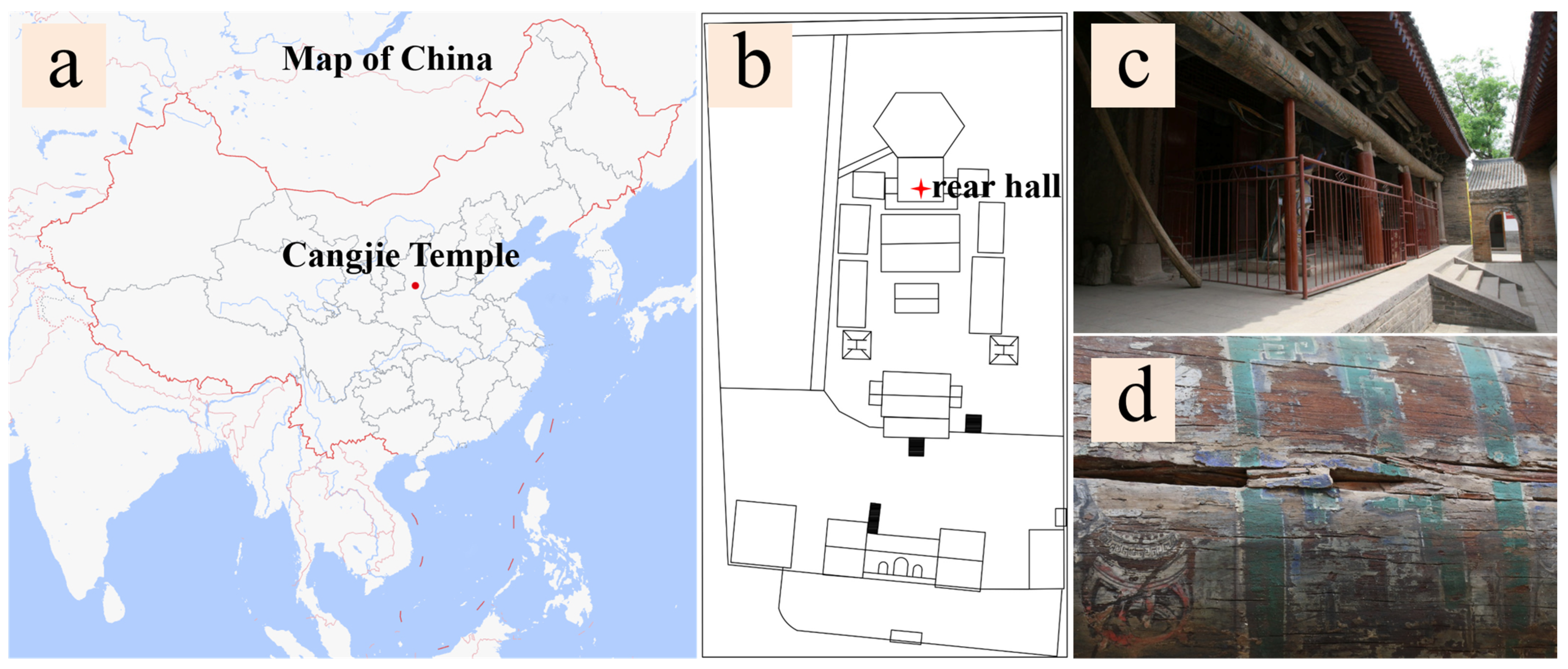

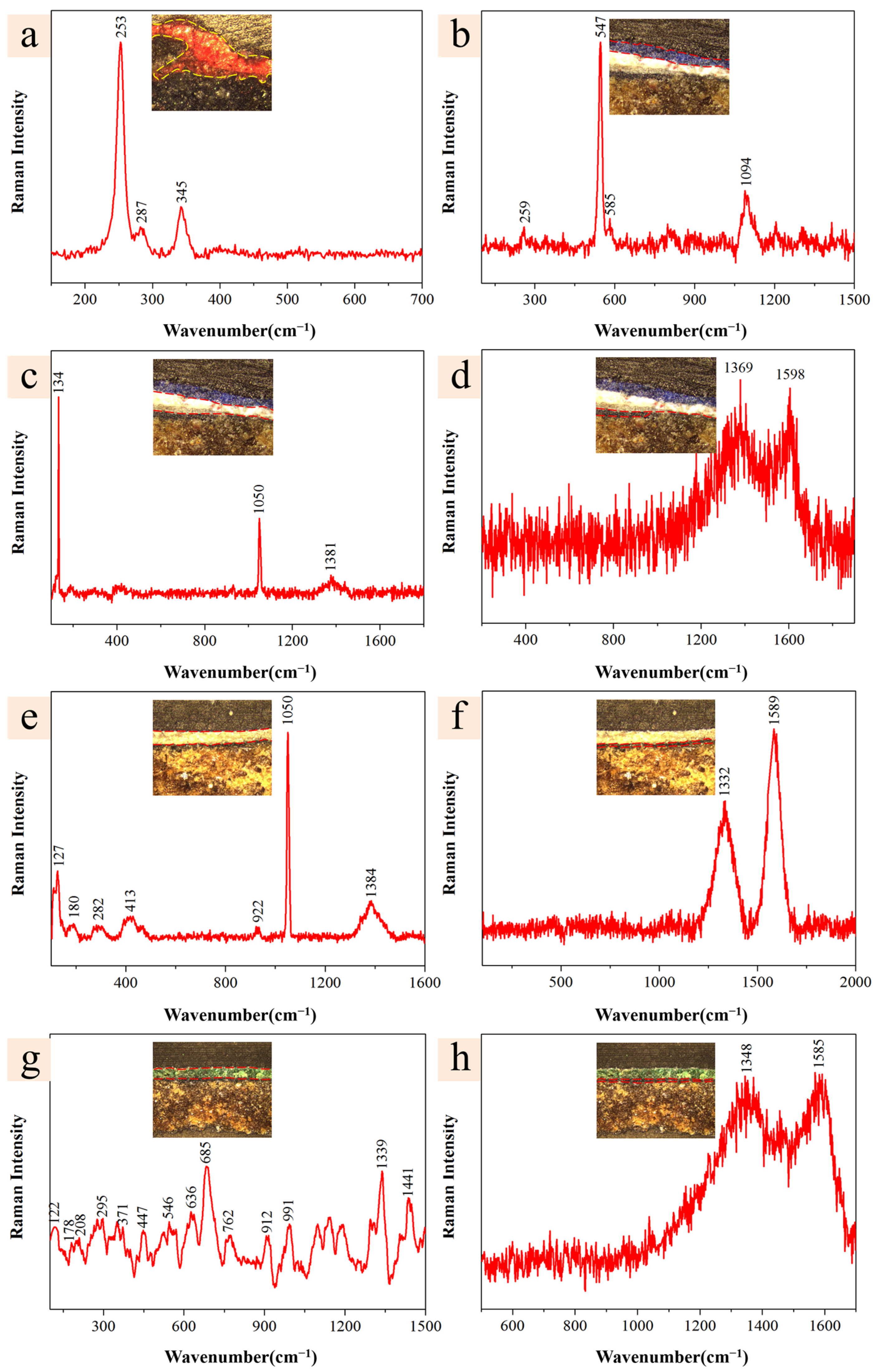
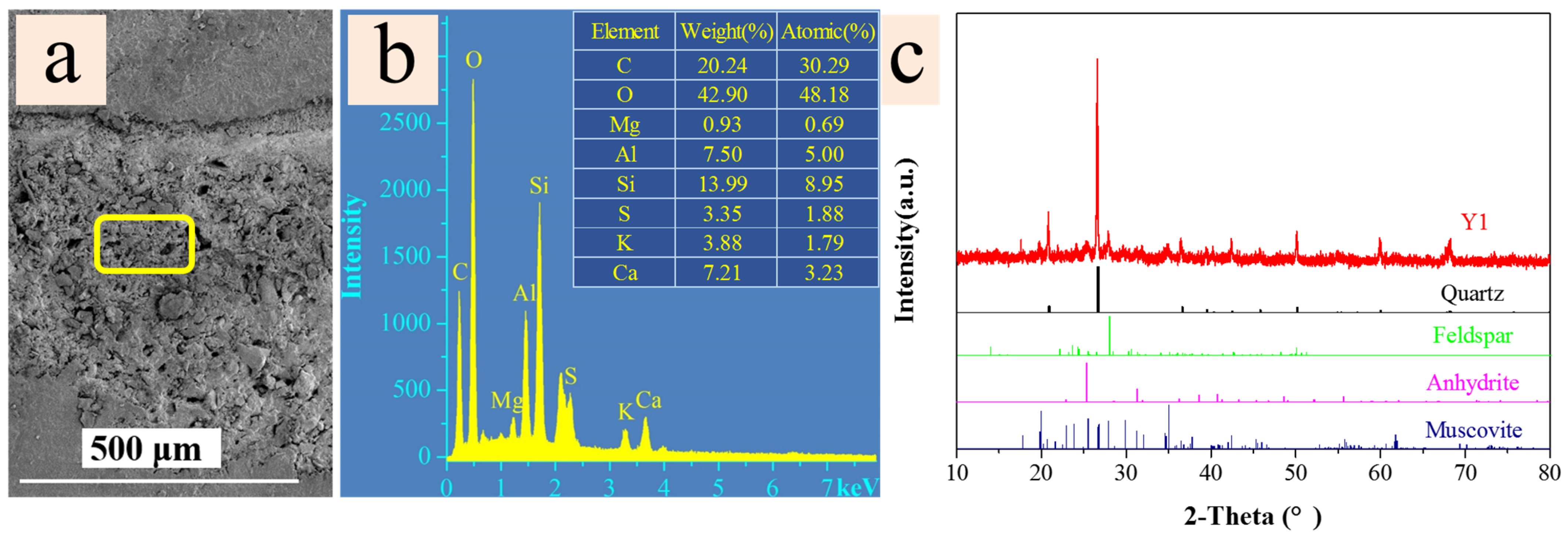
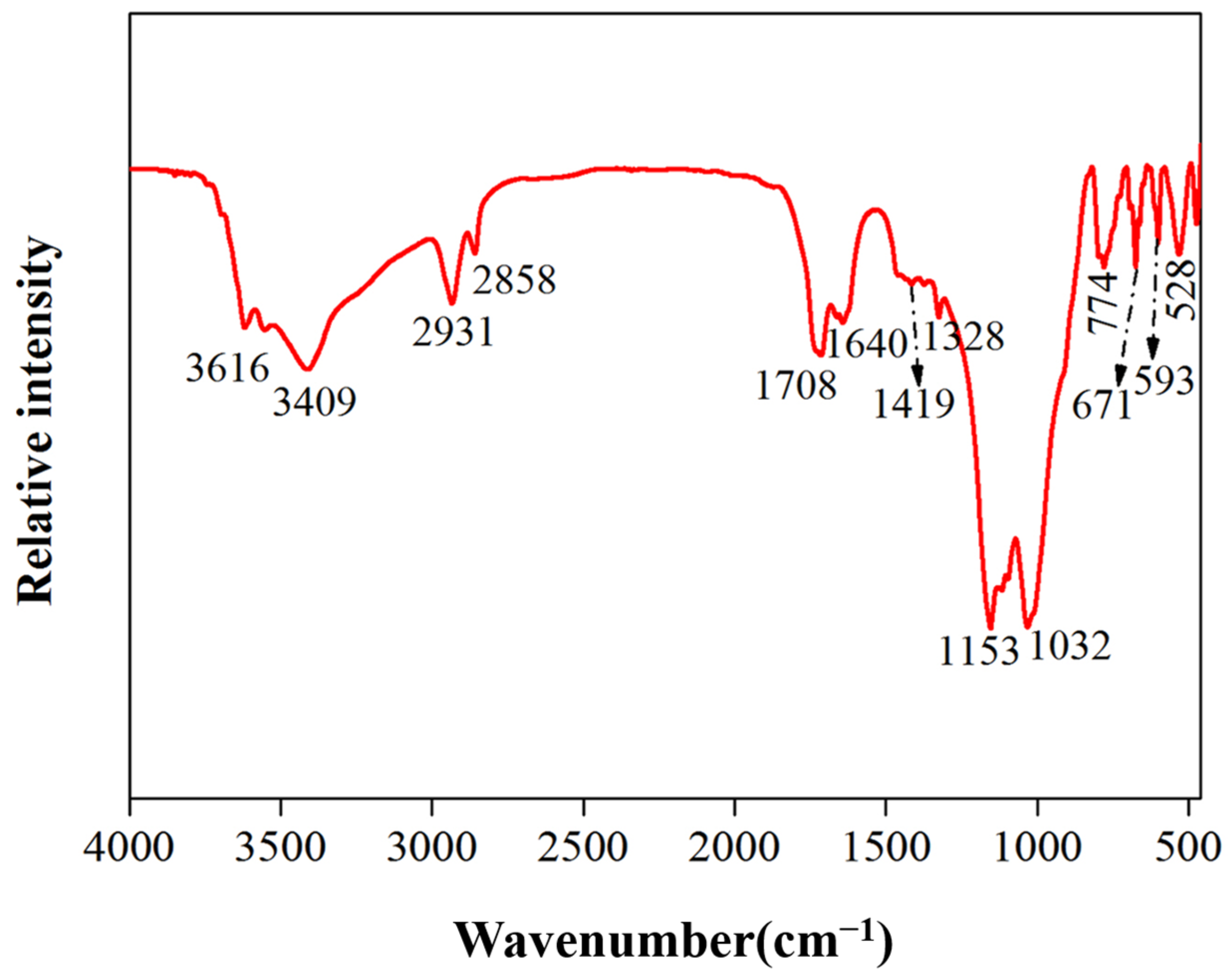
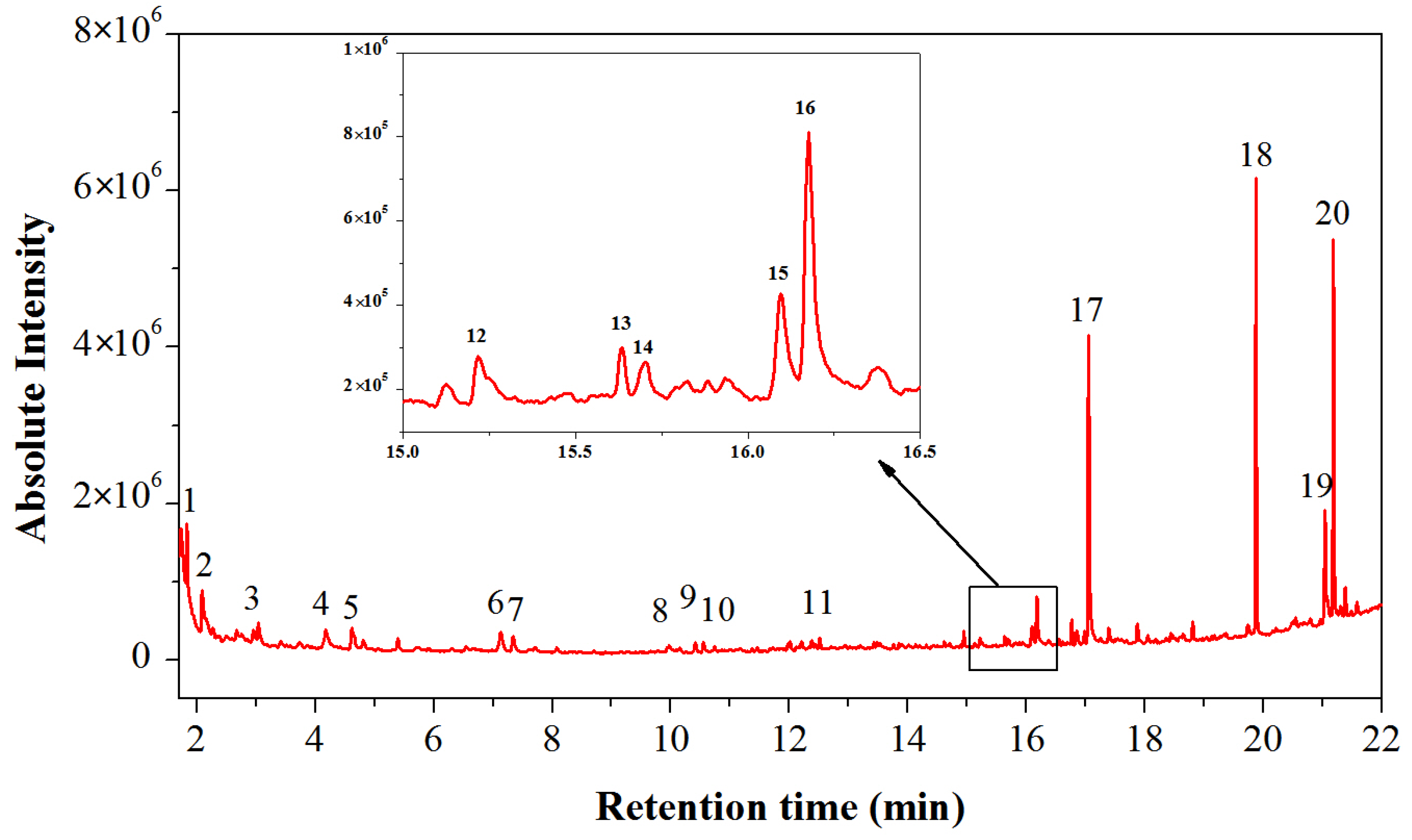
| Sample | Color Appearance | Analysis Methods | Elements |
|---|---|---|---|
| Y1 | Red | SEM-EDS, m-RS, PLM Py-GC/MS, FT-IR, XRD | C, O, Al, Si, Hg, S, K, Ca |
| Y2 | Blue | SEM-EDS, m-RS, PLM | C, O, Na, Al, Si, S, Ca |
| White | SEM-EDS, m-RS, PLM | C, O, Pb | |
| Black | SEM-EDS, m-RS, PLM | C, O, Al, Si, S, Pb, Ca | |
| Y3 | White | SEM-EDS, m-RS, PLM | C, O, Mg, Al, Si, Pb |
| Black | SEM-EDS, m-RS, PLM | C, O, Mg, Al, Si, S, Pb | |
| Y4 | Green | SEM-EDS, m-RS, PLM | C, O, Cu, As |
| Black | SEM-EDS, m-RS, PLM | C, O |
| Peak Number | Retention Time (min) | Area (%) | Identified Compounds |
|---|---|---|---|
| 1 | 1.833 | 4.04 | Acethydrazide |
| 2 | 2.093 | 3.12 | 2-methyl-1-pentanol |
| 3 | 3.042 | 4.35 | Valeraldehyde |
| 4 | 4.176 | 3.58 | Toluene |
| 5 | 4.618 | 2.72 | 1-Octene |
| 6 | 7.132 | 2.51 | Cyclohexanone |
| 7 | 7.339 | 1.7 | Glyceryl methyl ether |
| 8 | 9.971 | 1.13 | 2-Octanone |
| 9 | 10.412 | 0.89 | Cycloheptanone |
| 10 | 10.55 | 0.91 | 6-Heptenoic acid methyl ester |
| 11 | 12.512 | 0.64 | Caprylic acid methyl ester |
| 12 | 15.217 | 0.87 | Glycinamide monohydrochloride |
| 13 | 15.633 | 0.37 | 1-Tetradecene |
| 14 | 15.702 | 0.38 | n-Nonadecane |
| 15 | 16.096 | 1.58 | Methyl 9-oxononanoate |
| 16 | 16.176 | 3.21 | Dimethyl suberate |
| 17 | 17.049 | 18.37 | Dimethyl azelate |
| 18 | 19.875 | 19.95 | Methyl palmitate |
| 19 | 21.039 | 7.75 | Methyl oleate |
| 20 | 21.183 | 17.11 | Methyl stearate |
| Sample Number | Color | Sample Image | Optical Microscopic Image | |
|---|---|---|---|---|
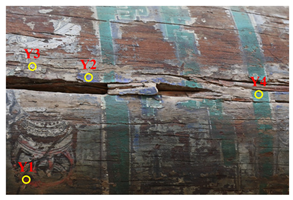 | Y1 | Red | 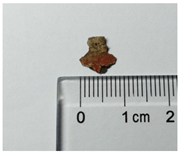 | 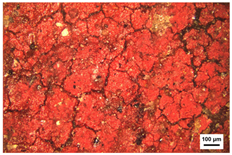 |
| Y2 | Blue | 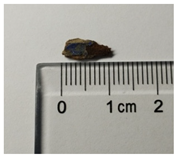 | 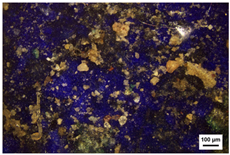 | |
| Y3 | White | 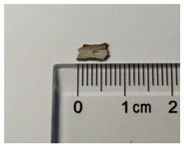 | 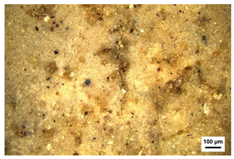 | |
| Y4 | Green |  |  |
Disclaimer/Publisher’s Note: The statements, opinions and data contained in all publications are solely those of the individual author(s) and contributor(s) and not of MDPI and/or the editor(s). MDPI and/or the editor(s) disclaim responsibility for any injury to people or property resulting from any ideas, methods, instructions or products referred to in the content. |
© 2024 by the authors. Licensee MDPI, Basel, Switzerland. This article is an open access article distributed under the terms and conditions of the Creative Commons Attribution (CC BY) license (https://creativecommons.org/licenses/by/4.0/).
Share and Cite
Huang, D.; Han, K.; Teri, G.; Cheng, C.; Qi, Y.; Li, Y. Material and Microstructure Analysis of Wood Color Paintings from Shaanxi Cangjie Temple, China. Molecules 2024, 29, 2734. https://doi.org/10.3390/molecules29122734
Huang D, Han K, Teri G, Cheng C, Qi Y, Li Y. Material and Microstructure Analysis of Wood Color Paintings from Shaanxi Cangjie Temple, China. Molecules. 2024; 29(12):2734. https://doi.org/10.3390/molecules29122734
Chicago/Turabian StyleHuang, Dan, Kezhu Han, Gele Teri, Cong Cheng, Yunpeng Qi, and Yuhu Li. 2024. "Material and Microstructure Analysis of Wood Color Paintings from Shaanxi Cangjie Temple, China" Molecules 29, no. 12: 2734. https://doi.org/10.3390/molecules29122734
APA StyleHuang, D., Han, K., Teri, G., Cheng, C., Qi, Y., & Li, Y. (2024). Material and Microstructure Analysis of Wood Color Paintings from Shaanxi Cangjie Temple, China. Molecules, 29(12), 2734. https://doi.org/10.3390/molecules29122734






